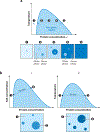Biological Phase Separation and Biomolecular Condensates in Plants
- PMID: 33684296
- PMCID: PMC8221409
- DOI: 10.1146/annurev-arplant-081720-015238
Biological Phase Separation and Biomolecular Condensates in Plants
Abstract
A surge in research focused on understanding the physical principles governing the formation, properties, and function of membraneless compartments has occurred over the past decade. Compartments such as the nucleolus, stress granules, and nuclear speckles have been designated as biomolecular condensates to describe their shared property of spatially concentrating biomolecules. Although this research has historically been carried out in animal and fungal systems, recent work has begun to explore whether these same principles are relevant in plants. Effectively understanding and studying biomolecular condensates require interdisciplinary expertise that spans cell biology, biochemistry, and condensed matter physics and biophysics. As such, some involved concepts may be unfamiliar to any given individual. This review focuses on introducing concepts essential to the study of biomolecular condensates and phase separation for biologists seeking to carry out research in this area and further examines aspects of biomolecular condensates that are relevant to plant systems.
Keywords: biomolecular condensates; membraneless organelles; protein phase separation.
Figures




References
-
- Alberti S, Dormann D. 2019. Liquid-liquid phase separation in disease. Annu. Rev. Genet 53:171–94 - PubMed
Publication types
MeSH terms
Grants and funding
LinkOut - more resources
Full Text Sources
Other Literature Sources
Research Materials
Miscellaneous

